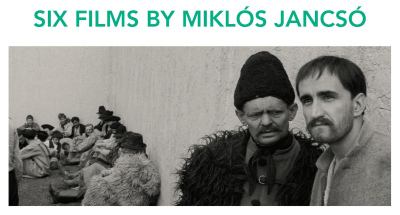
The Films of Hungarian Master Miklós Jancsó
Jan 14 – 20 at the Metrograph in NYC
both in Theater and Home
Kino Lorber presents new 4K restorations from the original camera negatives by the Hungarian National Film Archive
“The greatest Hungarian film director of all time.” – Béla Tarr
“The master of the long shot.” – Martin Scorsese
Long before Béla Tarr established himself as the Hungarian master of the long take, there was Miklós Jancsó, whose epic 1965 historical drama The Round-Up Tarr counts among his favorite films of all-time. Jancsó, whose directing career began in the 1950s, became an international arthouse sensation in the ’60s, renowned at home and abroad for works like The Red and the White (1967) and Red Psalm (1971), which combine a breadth of scale to rival Visconti, a keen eye for the telling historical detail, and an unbelievably intricate, arabesque choreography of bodies in motion. Jancsó’s films have been less screened in recent years, owing to the paucity of decent materials, but this selection of six new restorations brings them roaring back in all of their broad-shouldered splendor, emotional impact, and epic scope. Films that have to be seen—and preferably seen big—to be believed.

THE ROUND-UP | 1965 | 87 min
Miklós Jancsó’s breakout film is a spellbinding drama set in the aftermath of the 1848 Hungarian Revolution. After the Hapsburg monarchy succeeds in suppressing Lajos Kossuth’s nationalist uprising, the army sets about arresting suspected guerillas, who are subjected to torture in an effort to extract information about outlaw highwayman Sándor Rózsa’s band of partisans, still waging armed struggle against the Hapsburgs on the outside. Jancsó’s camera stays in constant, hypnotic motion, taking in the developing dynamics and antagonisms between the prisoners and their captors, meditating upon and exalting its characters’ resistance and perseverance in the face of brutal, authoritarian repression.
“I have never really been exposed to such a sensibility in the camera movements before… and the ending of The Round-Up is one of the greatest summations of a picture ever created.” – Martin Scorsese, Cannes Film Festival 2010
THE RED AND THE WHITE | 1967 | 87 min
The film takes place in 1918 on Soviet territory and reveals the murderous clashes between Red troops and the overwhelming White guards. The commander of the Hungarian volunteers stationed in the monastery at Ipatyev prepares for the execution of White prisoners, but in a few minutes, it is the Whites who begin a terrible slaughter over his corpse. Only a couple of Hungarians escape. This beautiful black and white film by Jancsó dissects with surgical precision the mechanisms at work behind every war. The film was commissioned by the Soviet Union for the 50th anniversary of the 1917 revolution but Jancsó’s version has never been screened in Russian movie theatres. It was listed to compete in Cannes, but the festival was canceled due to the events of May 1968 in Paris.
“If you’ve never encountered Jancsó’s work, you shouldn’t miss this. He may well be the key Hungarian filmmaker of the sound era, and certain later figures such as Bela Tarr would be inconceivable without him.” – Jonathan Rosenbaum, Chicago Reader
THE CONFRONTATION | 1968 | 78 min
Set in 1947, the Communist Party has just taken power in Hungary. Young communist students at a People’s College have a debate with Catholic seminary students, but worry it will escalate into a fight. Jancsó’s first color film raises questions of democracy and power.
“As always with Jancsó, one feels the terrifying presence of some invisible power pulling the strings… I would hazard that this might be his best film since The Round-Up.” – Tom Milne, The Observer
WINTER WIND | 1969 | 71 min
1934. Croatian separatists, supported by Hungary, seek Croatia’s independence from Yugoslavia. Shortly before the assassination of Yugoslavia’s King Alexander in Marseilles, Marko Lazar is among a band of these separatists. Marko’s youth is dissolving into his mortality, his idealism marking him for his end. The film consists largely of fluid long takes amongst twelve shots. With the sweeping motion of its camera, Jancsó manages to communicate the abstract conflict between the idealists and reality.

RED PSALM | 1971 | 74 min
The film honors the agrarian Socialist movements of the end of the last century, at the same time conveying a historical and philosophical critique of the Socialist ideas. Stylized dance with collective choreography depicts the fight of those answering terror with violence: the fight between oppressors and the downtrodden. Harvesters are going on strike. The bailiff sets fire to wheat sacks to intimidate them. The new-come armed units conquer the harvesters in gunfire.
“May well be the greatest Hungarian film of the 60s and 70s.” – Jonathan Rosenbaum, Chicago Reader

ELECTRA, MY LOVE | 1974 | 91 min
A two-thousand-year-old Greek myth resonates inescapably in twentieth-century Hungary. Electra is oppressed by Aegisthus, the tyrant who fifteen years earlier murdered her father, Agamemnon. The stylized and symbolic world of the Greek drama proved effective for Jancsó to draw a parallel between the figure of Aegisthus and János Kádár, leader of the Hungarian Communist Party. The film seeks opportunities for resistance and is highly critical of those forms of behavior through which the majority comes to terms with the tyrant. A cinematic tour de force: the entire 70-minute duration is covered by just twelve takes.
“A tour-de-force… Jancsó has mastered his form.” – Gene Moskowitz, Variety




